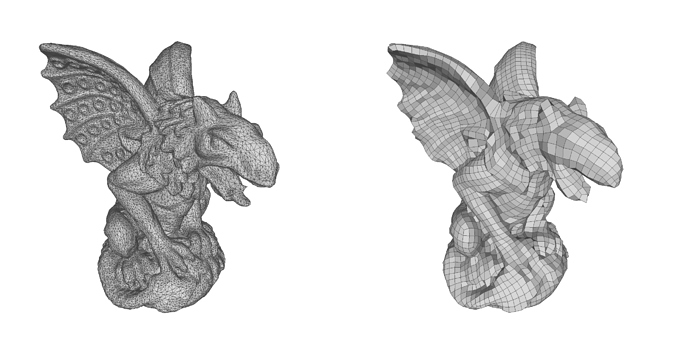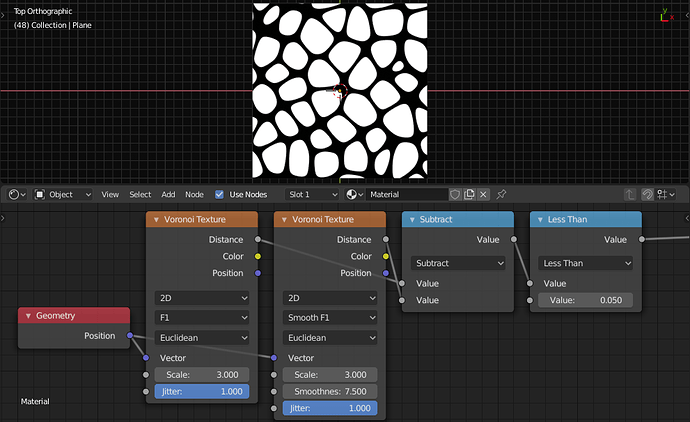Notes for the meeting of September 16th, 2019.
Announcements
- We now officially leaving the Bcon1 state of Blender2.81 with only a critical patch pending.
- Google Summer of Code 2019 wrap up post.
Blender 2.81 Bcon2
- Welcome everyone to Blender 2.81 Bcon2.
- Developers are expected to work on bugfixing and polishing the features that were committed.
- All hired developers are to work on the tracker regularly (once a week usually), but during Bcon2 more activity there is expected (50%-100% of the week).
- To help us going over the >400 reports we are working in a bug triaging playbook.
- Bcon3 starts on October 10th, together with Blender 2.82 Bcon1.
New Features and Changes
Sculpting
Many new sculpting features were added. (Pablo Dobarro)
Tools
- Pose brush: pose a model simulating an armature-like deformation. The pivot point for rotation is calculated automatically based on the radius of the brush and the topology of the model.
- Translate, Rotate, Scale tools: transform around a pivot point, also taking into account symmetry.
- Elastic Deform brush: grab, biscale grab, triscale grab, scale and twist operations that preserve volume. All deformation modes are accessible under the same tool. Based on the “Regularized Kelvinlets: Sculpting Brushes based on Fundamental Solutions of Elasticity” paper.
- Draw Sharp brush: Similar to the draw brush, but it deforms the mesh from the original coordinates. When used with the sharper curve presets it has a much more pleasant crease/cut behavior than any of the other brushes. It is useful for creating cloth wrinkles, stylized hair or hard surface edges.
- Mesh Filter tool: applies a deformation to all vertices in the mesh at the same time. It includes multiple deformation modes and the option to lock the deformation axis.
Brush Settings
- Automasking: assigns a factor to each vertex before starting the stroke. Topology automasking affects only vertices connected to the active vertex.
- Grab active vertex snaps the maximum strength of the grab brush to the highlighted active vertex, making it easier to manipulate low poly models or meshes with subdivision surfaces.
- Dynamic Mesh Preview displays the edges of the mesh inside the brush radius. This helps to visualize the real geometry the user is manipulating from sculpt mode when there are active modifiers.
Masking
- Mask Filter: modifies the whole paint mask. In includes multiple operations like smooth, grow or contrast accessible from a pie menu.
- Dirty Mask generator: similar to Dirty Vertex Colors, but it generates a paint mask. It can be used to mask cavities in the sculpt.
- Mask Expand: creates a mask from the active vertex to the vertex under the cursor based on topology or mesh curvature
- Mask Extract: extracts the paint mask to a new mesh object. It can extract the paint mask creating a boundary loop in the geometry, making it ready for adding a subdivision surface modifier.
Quad Remeshing
A new QuadriFlow remeshing method was added, to create a quad mesh with few poles and edge loops following the curvature of the surface. This method is relatively slow but generates higher quality for final topology, compared to Voxel Remesh. (QuadriFlow library) (Sebastian Parborg)
Library Overrides
The replacement system for proxies, called Library Overrides, is now enabled. (docs) (Bastien Montagne)
It is considered as experimental, and the current proxy system will be kept alongside for a few releases. A manual operator to convert proxies to library overrides will be added later, however results on complex characters are not guaranteed.
Compared to proxies, library overrides support:
- Multiple independent overrides of a same linked data (e.g. a whole character).
- Add new modifiers and constraints, anywhere in the stack.
- Override many more types of data-blocks, and selectively edit some of their properties. For example materials or textures.
- Recursively chain overrides, linking and override overrides from another library file.
Cycles Optix
Cycles now has experimental support for rendering with hardware-accelerated raytracing on NVIDIA RTX graphics cards. This is done by enabling Optix in Preferences > System > Cycles Render Devices. (Patrick Mours, Brecht Van Lommel)
This requires recent NVIDIA drivers and does not yet support all features of the CUDA backend. For more details see the release notes.
Shader Nodes
- Voronoi Texture node: new 4D mode, distance and position output, smoothing, randomness, distance to edge and n-sphere radius to create many different types of patterns. (examples) (Omar Ahmad)
- Musgrave Texture node: support for 1D, 2D, 3D and 4D dimensions. (Omar Ahmad)
- New Vertex Color node: for convenient access to Vertex Colors and their alpha channel. (Omar Ahmad)
File Browser
- Add back + - buttons for adding version numbers. (Julian Eisel)
- Colored folder icons. (Harley Acheson)
- Better volume descriptions on Windows. (Harley Acheson)
- Icons for desktop, external drive and network drive. (Andrzej Ambroż, William Reynish)
Sequencer
Prefetching support, to automatically fill the cache with frames after the current frame in the background. This can be enabled in the sequencer Preview, in the View Settings in the sidebar. (Richard Antalik)
Other
- Transform: mirroring over the Y and Z axis is now supported, along with the existing X axis option. Multiple axes can also be enabled simultaneously. (Germano Cavalcante)
- Transform: options to affect only origins or parents was moved from the pivot popover to the options panel. (Campbell Barton)
- Drivers: bone length is now a property that can be used for drivers. (Alexander Gavrilov)
- Python API:
depsgraph_update_postandframe_change_posthandlers can now optionally use adepsgraphargument. These and other callbacks also no longer run for preview renders, only the main scene. (details) (Sergey Sharybin) - Grease Pencil: new Simplify Tint option, to disable tinting on all layers. (Antonio Vazquez)
- Eevee: faster volume rendering for graphics card that support new OpenGL versions. (Clément Foucault)
- Cycles: option to display a render pass in the viewport, instead of the combined pass. (Jeroen Bakker)
- User Interface: use pageup/down and home/end to scroll to start/end of menus. (Joep Peters)
- Collections: each 3D viewport can now display a different subset of collections, by enabling Local Collections in the sidebar Collections panel. (Dalai Felinto)
Projects Under Development
- New patch for wireframe opacity control in uv editor waiting for review.

